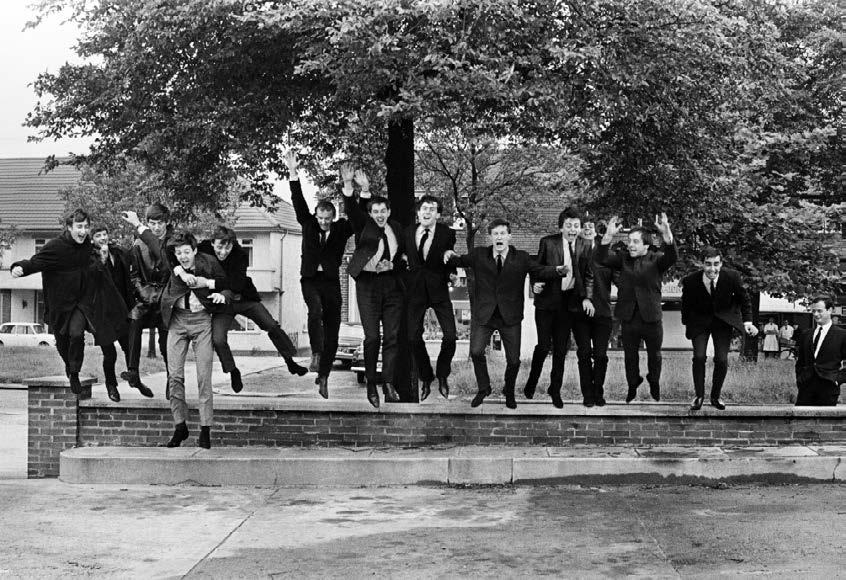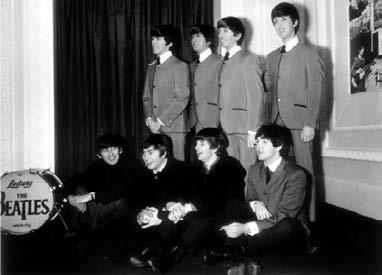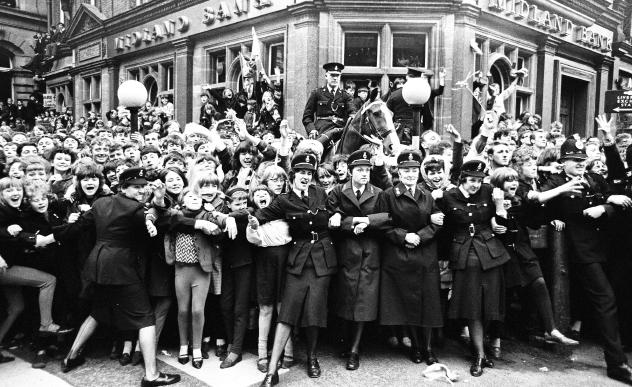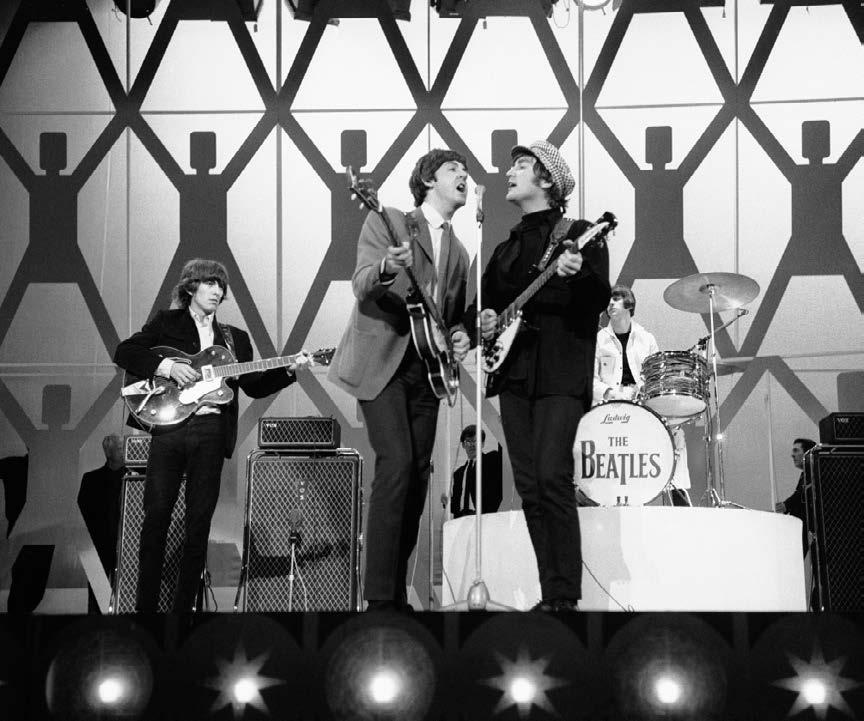INTRODUCTION page 6
2
1960-1961
THE BAND IS BORN page 20
5 CONTENTS
4
1966-1969 THE GREATEST BAND IN THE WORLD page 136
1
1956-1959 THE BEATLES BEFORE THE BEATLES page 14
3
1962-1965 FROM THE FIRST RECORD TO TOTAL TRIUMPH page 30
1970-1975
THE LONG GOODBYE page 198
it takes to build a career in the music industry. The Indra performances ended earlier than planned, on October 3rd, as many of the Indra’s neighbors complained about the noise the club produced every night. So the Beatles moved on to the Kaiserkeller, a bigger club with a real stage that could accommodate a much large audience. On October 4th, they began a series of 56 nights at the club, which was on the same street (the Große Freiheit) as the Indra. The audiences were typically made up of sailors, gangsters, prostitutes, drunks, young people, and passersby, and the band shared the evening concerts with another Liverpool group, Rory Storm and the Hurricanes, which had an excellent drummer by the name of Ringo Starr.
26-27 February 1961:
26 The Beatles during their first series of concerts in Hamburg in 1960, when they backed Tony Sheridan.
The Beatles onstage at the Cavern Club in Liverpool.
In the meantime, the four had already begun preparing their second album, recording from mid-July and through the following months, when they weren’t performing, touring, or making appearances on TV and radio. They released several EPs with songs from their singles, all of which promptly continued to rise on the charts. The band had real momentum now. The Liverpool period ended on August 3rd, 1963, when the Beatles— along with the Merseybeats, The Escorts, The Roadrunners,
THE LAST CAVERN CONCERT
WAS ON AUGUST 3RD, 1963. THE CLUB WAS TOO SMALL FOR THE SUCCESS OF THE BAND
The Sapphires, and Johnny Ringo & The Colts—played for the last time at the Cavern, which had become too small to contain their success.
For the first time in years, they enjoyed a brief vacation in late September. George went to the United States with his sister Louise. John and Cynthia went to Paris, while Paul and Ringo decided to spend time by the sea in Greece. When they all returned home, they immediately went to the studio to record the second album. They also had to prepare for their debut on Ready, Steady, Go!, the BBC’s most important music program.
48-49 July 18th, 1963, a group photograph of the Liverpool bands managed by Brian Epstein (seen at the far right): The Beatles, Gerry and The Pacemakers, and Billy J Kramer & The Dakotas.
76-77 Paul McCartney examines his wax double at the Madame Tussauds museum in London.
77 The Beatles sitting in front of their wax statues at Madame Tussauds in April 1964.
132 Paul McCartney and George Harrison during a concert held in Sweden in 1965.
132-133 The Beatles during the rehearsals for the broadcast of the ABC-TV Blackpool Night Out program, performed at the ABC Theatre of Blackpool on August 1st, 1965.
The trip to Rishikesh led an entire generation to India by revealing its spirituality, its culture and its search for wisdom.
The second Beatle to begin working on solo music projects (after Paul, who wrote the soundtrack for the movie The Family Way) was George. He left for India in early 1968 to record the soundtrack for the movie Onyricon. He also wanted to record music with a group of Indian musicians in Mumbai. When he returned to England, the four began working together again. In early February of 1968, they recorded “Lady Madonna” and “Across the Universe.” The former was written by Paul, and John wrote the latter. Then, in the middle of the month, the band decided to follow George to Rishikesh to explore transcendental meditation. The trip was meant as a religious retreat, as the band would study meditation with Marahishi Mahesh Yogi. Their group included the singer Donovan Philips Leitch, Mia Farrow and her sister, Mike Love of the Beach Boys, and many others. For the Beatles, the trip served as a gateway to Indian culture and music. And due to the media that followed the band, many young people in the United Kingdom and the U.S. were exposed to the same things. This chapter in the band’s history would prove to be the last in which they were committed to writing music together.
The Beatles returned separately from India; Ringo stayed for two weeks, Paul a little more than a month, and John and George for almost two months. Each was searching for his own path and, while each member was still officially a Beatle, it seemed that the magic had been lost. This was especially true for George, who suffered from the domination of the Lennon/McCartney composer duo. During this time, John, who had fallen in love with Yoko and had separated from Cynthia, discovered new forms of artistic expression and became increasingly attached to his new partner. Paul had broken free from the need to include John in all his music writing; for months now, he had led a completely independent life and had contemplated a solo career. Ringo was arguably the only member with a strong interest in preserving the band, and in many books about the Beatles, Ringo is often acknowleged as the glue that kept the four from drifting apart completely.
170-171 The Beatles and their friends in Rishikesh, India in March 1968. The group includes Ringo with his wife Maureen, Jane Asher, Paul, George and his wife Patti, John and Cynthia Lennon, Mal Evans, Mia Farrow and her sister Prudence, Donovan and his girlfriend Jenny Boyd, and the Beach Boy Mike Love.
Each member began to drift his own way. This development didn’t suit McCartney. He decided to meet with the other three to propose a new project. He suggested a return to their musical roots: only the four of them with their instruments and minus all the recording studio technology. They would rehearse for a big end-of-show concert at Twickenham Studios. These rehearsals would be filmed so that the audience could see the process of writing and recording rock songs. The others agreed, although they weren’t convinced that they should go back to playing live. They did appreciate the idea of returning to their roots, especially George, who had just performed in an acoustic set in America with Bob Dylan and the Band. The recording sessions of this new project, provisionally titled Get Back, began on January 2nd, 1969, in Twickenham Studios, but it quickly
The Beatles during their last CONCERT on the roof of Apple Corps in London
devolved into a kind of psychodrama filmed under the direction of Michael Lindsay-Hogg. Paul tried to control the recordings of the band, but this only triggered a negative reaction from the others, especially Harrison, who found it difficult to tolerate McCartney’s constant ‘suggestions.’ Furthermore, it seemed that Lennon was mentally absent; he arrived late to many sessions and was frequently under the influence of various drugs. It wasn’t uncommon for Lennon to be oblivious of the decisions made by the rest of the band. He stayed by Yoko’s side and objected to the presence of so many cameras.
188-189 January 30th, 1969: The Beatles perform live for the last time on the roof of Apple Corps in London. The set was organized and filmed for the documentary Let It Be, directed by Michael Lindsay-Hogg.


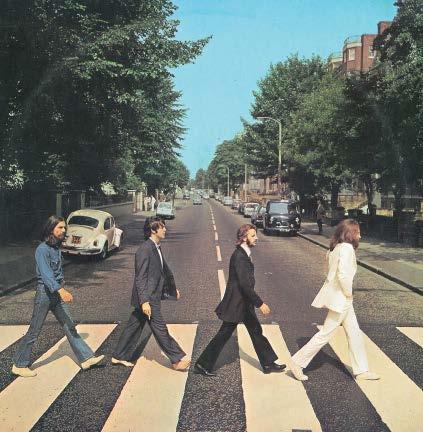
However, by April of 1969, the Beatles had returned to the recording studio at Paul’s insistence to make their eleventh studio album, Abbey Road. The album was nothing short of a miracle. The band was aware that this might be the last time they would ever cut a record together, and they all did their very best to finish the recordings. To this day, when one listens to the tracks of Abbey Road (like “Come Together,” “Oh Darling,” “Something,” and “Here Comes the Sun”), the feelings produced are a complex knot of sadness, joy, and hope. The lovely final medley (not including the hidden “Her Majesty” track) on side two of the record is titled “The End” and clearly signifies the conclusion of the Beatles’ musical adventure: “And in the end, the love you take / is equal to the love you make.” One gets the impression that the four were in a true state of grace. The creativity, emotional expression, and communicative ability of the band proved perfectly intact despite the tension. The
THE ZEBRA CROSSING
IN FRONT OF EMI’S ABBEY ROAD STUDIOS in London has become a national monuments
album was released on September 26th, 1969, and took the fourth spot of the best-selling albums of the 1960s. The album’s cover also became famous. The four members of the band are featured walking through the crosswalk of Abbey Road in London. This crosswalk has become a national monument and is visited every year by thousands of tourists from all over the world. Despite early criticism that the Beatles had lost their touch, many now consider the album one of their best.
On September 12th, after being invited to play at the Toronto Peace Festival and having
192 The iconic cover of the album Abbey Road, recorded in 1969. It consisted of the band’s last official recordings. From left to right: Harrison, McCartney, Starr, and Lennon walk on the zebra crossing in front of EMI’s Abbey Road Studios.







